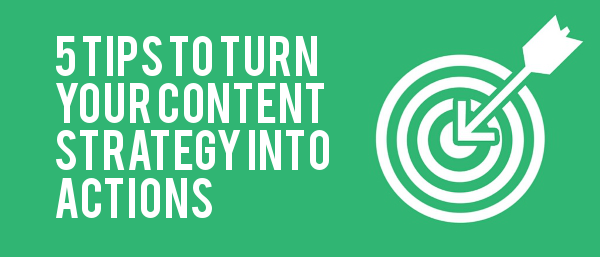
5 Tips To Turn Your Content Strategy Into Actions
13 April 2016, Anne Caborn

At the risk of stating the obvious: knowing something isn’t the same as doing something. Likewise, acquiring and extending your knowledge about content strategy isn’t the same as content strategy happening within your organisation.
If knowing and doing were the same things, understanding how diets work would result in weight loss, and looking at the design spec for a McLaren F1 race car would transform into Stoffel Vandoorne.
Ironically, what often prevents content strategy being turned into actions is not the enormity of the task, but a failure to appreciate that the most impressive strategic transformations can often be broken down into surprisingly doable bite-size pieces.
The top 5 tips below are the ones that make things happen, based on the experiences of the people who attend my digital content strategy workshop. The tips work for them. They work for me. They’ll work for you.
1. Getting out from behind your desk
Richard Branson, Mark Zuckerberg, Larry Page, Anne Mulcahy… didn’t become world famous business leaders because they stoically sat at their desks wading through the ALL the paperwork. They left some things undone. Instead, they majored in communicating and that meant spending more time by the water cooler and less behind a desk.
How might that work in practice?
When you look at revamping content tools, systems and processes – such as, say, developing a better content calendar – a key question should be “How does this free up my time to act more strategically?” Don’t just do more of the same.
2. Working smarter – not longer
Nobody became more strategic by working longer. The key is using time more efficiently and smarter time management hinges on time planning.
How might that work in practice?
Let’s stick with the content calendar as an example as it’s a critical tool when it comes to planning. The calendar* needs to break down content delivery into key phases and actions, each one with an owner (not just you). Think in terms of how it shows other people actions and responsibilities not just your oversight of the process. Groom people to take over small actions and then slowly increase their autonomy.
* What a content calendar can look like. You can find some useful examples here.
3. Bite size pieces
Content strategy implementation is all about breaking everything down into component steps. So think about marking key dates in the process (alongside who does them) – not just the final outcome. When it comes to ownership, beware of putting too many or too few names down against action.
If only one person is responsible, what happens if they’re not around – see point 5.
How might that work in practice?
Let’s take content creation. Key dates might look like this:
- Brainstorm ideas – owner/s of this action (OOTA)
- Agree use/business case and purpose ((OOTA)
- Agree time to delivery (OOTA)
- Create/Deliver brief (OOTA)
- Review delivered content (OOTA)
- Sign off (compliance etc) (OOTA)
- Deploy (OOTA)
- Review initial stats against agreed purpose (OOTA)
- Adjust (OOTA)
- Codify (more on Codify later)
Monitoring each stage also gives you a better feel for where the process sticks. Work iteratively and adjust timescales for the sticking places (eg compliance).
4. Progress should be obvious
Everything you do to implement your strategy should be overt not covert. Ultimately your content calendar and other key tools, such as content audits and comparator research* may be spreadsheets or Word docs (ideally on cloud drives for easy collective access), but nothing beats a strategically placed whiteboard showing top level/mission-critical deadlines, stakeholders/owners and a green/amber/amber colour coding to indicating what’s being done (or not done).
* You can find a useful list of content strategy documents here
How might that work in practice?
For example, imposing tools from the top down tends not to work. A better approach is collectively agreeing how tools and processes, such as your content calendar, need to function. So the first component is arranging a meeting when key people get to discuss and agree things like this. These should be a short meetings. Work with frieze paper on the walls and photograph and share the output. That way everybody gets to see what was agreed (which makes deniability so much harder).
5. Bus, fuss and codification
I used to work with someone whose response to everything was: “If it wasn’t written down it didn’t happen”. The point is a good one. If you, or the person responsible for a particular part of the content process, gets run over by a bus tomorrow (or headhunted at a vastly inflated salary) are instructions left behind (on that cloud drive) that enable replication and scaling up of everything important you, or they, do?
The advantage of this is there’s less fuss when the process needs to be done again. You can give How tos to an intern or a new team member; so much simpler (and less time consuming) than showing them. They can still come to you if they have questions.
How might that work in practice?
Codify the important/regular stuff. Don’t rely on collective memory or a shared tacit understanding of how things work. Simple lists (3 to 5 points), short How tos (single page), meeting notes (bulleted action points and their owners). Give them clear file names and place them in well-labelled folders on the cloud drive.
When anything works well, a social media campaign, for example, the first thing to do is review the current How to and if it’s not been written down before – write down (in brief) what you did, why you did it and what you could do better next time. *
* Remember Point 3. Don’t try and do the above as a massive project in its own right. Just start today with the one thing you do most often or did most recently. Sometimes it’s useful to get someone else to do the codifying – as the doer may add in too much detail.


